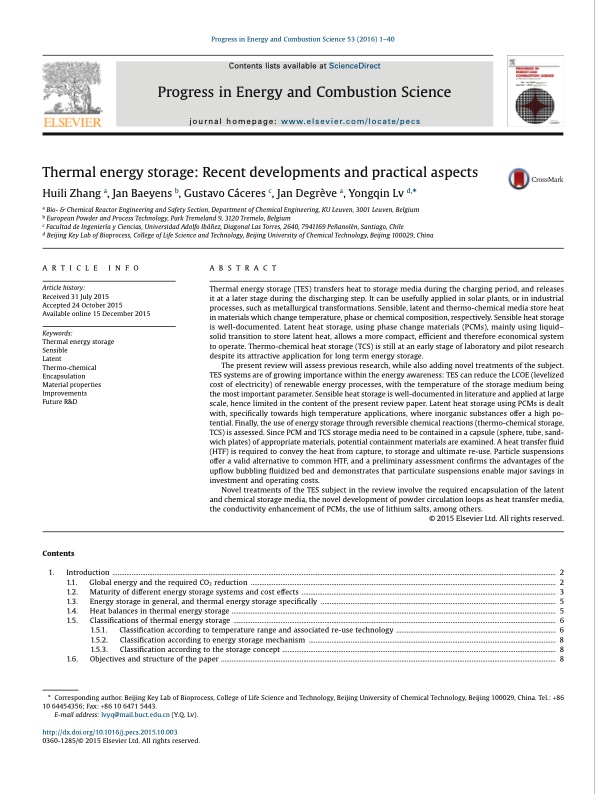
PDF Publication Title:
Text from PDF Page: 001
Progress in Energy and Combustion Science 53 (2016) 1–40 Contents lists available at ScienceDirect Progress in Energy and Combustion Science journal homepage: www.elsevier.com/locate/pecs Thermal energy storage: Recent developments and practical aspects Huili Zhang a, Jan Baeyens b, Gustavo Cáceres c, Jan Degrève a, Yongqin Lv d,* a Bio- & Chemical Reactor Engineering and Safety Section, Department of Chemical Engineering, KU Leuven, 3001 Leuven, Belgium b European Powder and Process Technology, Park Tremeland 9, 3120 Tremelo, Belgium c Facultad de Ingeniería y Ciencias, Universidad Adolfo Ibáñez, Diagonal Las Torres, 2640, 7941169 Peñanolén, Santiago, Chile d Beijing Key Lab of Bioprocess, College of Life Science and Technology, Beijing University of Chemical Technology, Beijing 100029, China ARTICLE INFO Article history: Received 31 July 2015 Accepted 24 October 2015 Available online 15 December 2015 Keywords: Thermal energy storage Sensible Latent Thermo-chemical Encapsulation Material properties Improvements Future R&D ABSTRACT Thermal energy storage (TES) transfers heat to storage media during the charging period, and releases it at a later stage during the discharging step. It can be usefully applied in solar plants, or in industrial processes, such as metallurgical transformations. Sensible, latent and thermo-chemical media store heat in materials which change temperature, phase or chemical composition, respectively. Sensible heat storage is well-documented. Latent heat storage, using phase change materials (PCMs), mainly using liquid– solid transition to store latent heat, allows a more compact, efficient and therefore economical system to operate. Thermo-chemical heat storage (TCS) is still at an early stage of laboratory and pilot research despite its attractive application for long term energy storage. The present review will assess previous research, while also adding novel treatments of the subject. TES systems are of growing importance within the energy awareness: TES can reduce the LCOE (levelized cost of electricity) of renewable energy processes, with the temperature of the storage medium being the most important parameter. Sensible heat storage is well-documented in literature and applied at large scale, hence limited in the content of the present review paper. Latent heat storage using PCMs is dealt with, specifically towards high temperature applications, where inorganic substances offer a high po- tential. Finally, the use of energy storage through reversible chemical reactions (thermo-chemical storage, TCS) is assessed. Since PCM and TCS storage media need to be contained in a capsule (sphere, tube, sand- wich plates) of appropriate materials, potential containment materials are examined. A heat transfer fluid (HTF) is required to convey the heat from capture, to storage and ultimate re-use. Particle suspensions offer a valid alternative to common HTF, and a preliminary assessment confirms the advantages of the upflow bubbling fluidized bed and demonstrates that particulate suspensions enable major savings in investment and operating costs. Novel treatments of the TES subject in the review involve the required encapsulation of the latent and chemical storage media, the novel development of powder circulation loops as heat transfer media, the conductivity enhancement of PCMs, the use of lithium salts, among others. © 2015 Elsevier Ltd. All rights reserved. Contents 1. Introduction ............................................................................................................................................................................................................................................................. 2 1.1. Global energy and the required CO2 reduction .............................................................................................................................................................................. 2 1.2. Maturity of different energy storage systems and cost effects ................................................................................................................................................. 3 1.3. Energy storage in general, and thermal energy storage specifically ...................................................................................................................................... 5 1.4. Heat balances in thermal energy storage ......................................................................................................................................................................................... 5 1.5. Classifications of thermal energy storage ........................................................................................................................................................................................ 6 1.5.1. Classification according to temperature range and associated re-use technology ........................................................................................... 6 1.5.2. Classification according to energy storage mechanism ............................................................................................................................................. 8 1.5.3. Classification according to the storage concept ............................................................................................................................................................ 8 1.6. Objectives and structure of the paper ............................................................................................................................................................................................... 8 * Corresponding author. Beijing Key Lab of Bioprocess, College of Life Science and Technology, Beijing University of Chemical Technology, Beijing 100029, China. Tel.: +86 10 64454356; Fax: +86 10 6471 5443. E-mail address: lvyq@mail.buct.edu.cn (Y.Q. Lv). http://dx.doi.org/10.1016/j.pecs.2015.10.003 0360-1285/© 2015 Elsevier Ltd. All rights reserved.PDF Image | Thermal energy storage: Recent developments

PDF Search Title:
Thermal energy storage: Recent developmentsOriginal File Name Searched:
3-Thermal-Energy-storage-recent-developments-and-practical-aspects.pdfDIY PDF Search: Google It | Yahoo | Bing
Turbine and System Plans CAD CAM: Special for this month, any plans are $10,000 for complete Cad/Cam blueprints. License is for one build. Try before you buy a production license. More Info
Waste Heat Power Technology: Organic Rankine Cycle uses waste heat to make electricity, shaft horsepower and cooling. More Info
All Turbine and System Products: Infinity Turbine ORD systems, turbine generator sets, build plans and more to use your waste heat from 30C to 100C. More Info
CO2 Phase Change Demonstrator: CO2 goes supercritical at 30 C. This is a experimental platform which you can use to demonstrate phase change with low heat. Includes integration area for small CO2 turbine, static generator, and more. This can also be used for a GTL Gas to Liquids experimental platform. More Info
Introducing the Infinity Turbine Products Infinity Turbine develops and builds systems for making power from waste heat. It also is working on innovative strategies for storing, making, and deploying energy. More Info
Need Strategy? Use our Consulting and analyst services Infinity Turbine LLC is pleased to announce its consulting and analyst services. We have worked in the renewable energy industry as a researcher, developing sales and markets, along with may inventions and innovations. More Info
Made in USA with Global Energy Millennial Web Engine These pages were made with the Global Energy Web PDF Engine using Filemaker (Claris) software.
Sand Battery Sand and Paraffin for TES Thermo Energy Storage More Info
| CONTACT TEL: 608-238-6001 Email: greg@infinityturbine.com | RSS | AMP |